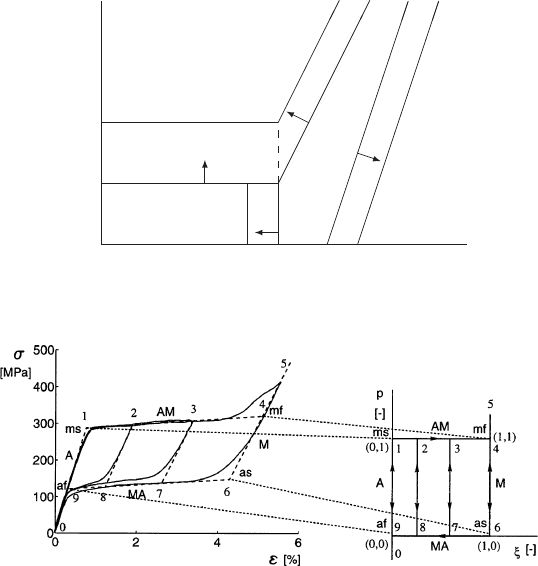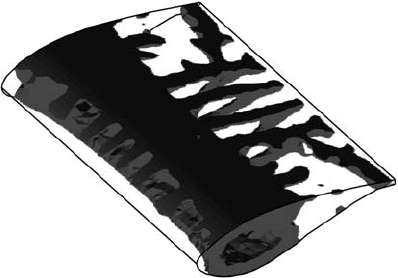Tong W. Wind Power Generation and Wind Turbine Design
Подождите немного. Документ загружается.


Implementation of The ‘Smart’ Rotor Concept 485
the phenomenological and curve fi tting models. The Young's modulus of the low
temperature martensite is lower than that of austenite. In all models it is assumed
to be linearly decreasing with increasing martensite fraction ( x ):
AM
() (1 )EEExxx=− +
(9 )
Thermodynamic models are based on potential energy functions. In these models,
the possible states are mathematically represented by ‘wells’, being local minima
of potential energy with respect to the shear length. The transformation dynam-
ics are described by the probability of a crystal being in one well to overcome
the energy barrier to jump to the next using Boltzmann statistics. One of the ear-
lier models for SMA behavior by Achenbach [ 88 ] is such a model. Others are by
Seelecke [ 87 ] and Massad et al. [ 89 ].
Phenomenological models, like those by Tanaka [ 90 ], Liang and Rogers [ 91 ]
and Brinson [ 92– 94 ] are also based on thermodynamic potential formulations, but
in these models often Gibs and Helmholtz free energy functions are employed
because they do not rely on entropy as an internal parameter [ 19 ]. So-called hard-
ening functions are assumed to describe the transformation dynamics. With these
models, the martensite fraction of the material is determined by using the s , T -state
of the material. The models differ in the way that transition areas are modeled.
Tanaka derives the following constitutive relation from the Helmholtz free energy:
ddEd T dse x=+Θ+Ω
( 10 )
In this equation E refers to the modulus of elasticity, Θ is related to the CTE and
Ω is called the ‘transformation tensor’. Equation (10) can be written in integral
form, with constant material properties:
00 0 0
()( )( )ETTss ee xx−= −+Θ− +Ω−
( 11)
Tanaka only distinguishes between austenite and martensite and models the stress-
temperature dependency of the martensite fraction x with an exponential function.
For the AM transition:
Ms M
()
M
s
M
1 exp for ( )
aMTb
a
TM
b
s
xs
−+
=− ≥ −
(12 )
and for the MA transition:
As A
()
A
s
A
exp for ( )
aATb
a
TA
b
s
xs
−+
=≤−
( 13 )
The coeffi cients a
M
, b
M
, a
A
and b
A
are dependent on the transitions’ start and fi n-
ish temperatures and the stress dependency of these temperatures, the Clausius
Clapeyron constants C
A
and C
M
. Assuming that the transition is complete with
99% conversion:
A
AA
fs A
2ln10
,
a
ab
AA C
==
−
(14 )

486 Wind Power Generation and Wind Turbine Design
M
MM
sf M
2ln10
,
a
ab
MM C
−
==
−
( 15 )
The shape functions for phase transition are valid on certain stress-dependent
temperature domains which can thus be plotted on the T , s -plane (see Fig. 13) .
s
MT
f
M
s
A
s
A
f
C
M
C
A
A
M
Figure 13: T , s -phase diagram from the Tanaka model. The arrows indicate in
which direction of the T , s -path the phase change occurs.
Here the graphical representation of the Clausius Clapeyron constant can
also be seen. Tanaka actually defi nes b
A
and b
M
in terms of the height of the
transition band:
A
A
2ln10
b
sΔ=
( 16)
M
M
2ln10
b
s
−
Δ=
( 17)
This constitutes the same as eqns (14) and (15) because of the defi nition of the
Clausius Clapeyron constants:
A
A
fs
C
AA
sΔ
=
−
( 18)
M
M
sf
C
MM
sΔ
=
−
( 19)
Liang and Rogers propose a similar model, but with a cosine-shaped dependency
of x on T and s .
For
Mf M Mf
()(/||) ():CTM b CTMps−− ≤≤ −
AA
MfM
11
cos( ( ) )
22
aTM b
xx
xs
−+
=−++
(20)
for the AM transition. For the MA transition the following holds.

Implementation of The ‘Smart’ Rotor Concept 487
For
As A As
()(/||) ()CT A b CT Aps−− ≤≤ −
:
[]
M
AsA
cos( ( ) ) 1
2
aT A b
x
xs=−++
( 21)
with:
A
AA
fs A
,
a
ab
AA C
p
−
==
−
( 22)
M
MM
sf M
,
a
ab
MM C
p
−
==
−
( 23)
and x
M
and x
A
are the start martensite fractions at the beginning of the respective
transformations. a
M
, b
M,
a
A
and b
M
are slightly differently defi ned than in the
Tanaka model, but they constitute the same physical meaning.
Brinson makes a distinction between temperature induced, multi variant
(‘twinned’) martensite and stress induced, single variant (‘detwinned’) martensite.
The constitutive is relation is then rewritten, also taking into account non-constant
material properties:
000s0s00
() ( ) () ( ) ( )EE TTss xe xe xx xx−= − +Ω −Ω +Θ−
( 24)
where the subscript ‘s’ denotes the stress induces, detwinned martensite. Brinson
also explains that:
L
() ()ExexΩ=
( 25)
In which e
L
is the maximal recoverable strain. Thus eqn (24) reduces to:
Ls 0 0
()( ) ( )ETTKsxeex=−+Θ−+
( 26)
where K
0
is a collection of terms that represent the initial conditions:
00 00s0L
()( )KEsxexe=− −
( 27)
This parameter is dependent on the loading history of the material. Brinson, like
Liang and Rogers, also assumes a cosine-shaped transition path. Unlike Liang
and Rogers, Brinson makes no distinction between the fraction at the start of the
AM or MA transition and denotes the state at the beginning of the transition with
the subscript ‘0’. Because of the distinction between twinned and detwinned mar-
tensite, below M
s
another transition is introduced for the formation of detwinned
martensite, also following a cosine-shaped path. For T < M
s
and
cr cr
sf
:sss<<
cr
s0 s
sf
cr cr
sf
110
cos ( )
22
xx
p
xss
ss
⎡⎤
−+
=−+
⎢⎥
−
⎣⎦
( 28)
t0
st0 ss0 t
s0
()
1
x
x
xx xx
x
=− − +Δ
−
( 29)
with, if M
f
< T < M
s
and T < T
0
:

488 Wind Power Generation and Wind Turbine Design
t0
Mf
1
cos( ( ) 1
2
T
aTM
x
x−
Δ= − +
( 30)
Else:
0
Tx
Δ= ( 31)
Subscript ‘t’ denotes temperature induced martensite. If the temperature is below
M
f
the detwinning is only stress-dependent. But if the temperature is between M
f
and M
s
, the model takes into account the formation of detwinned martensite due
to cooling through the AM transition zone. This is captured in the Δ
T x
parameter.
If the stress is below
cr
s
,s only twinned martensite is formed. For the formation of
detwinned martensite above M
s
Brinson derives the following.
For T > M
s
and
cr cr
sM s fM s
() ():CTM s CTMsss+−<<+−
cr
s0 s0
sfMs
cr cr
sf
11
cos ( ( ))
22
CTM
xx
p
xss
ss
⎡⎤
−+
=−−−+
⎢⎥
−
⎣⎦
(32)
The function for the formation of austenite above A
s
is the same as with Liang and
Rogers, but a function for the split in stress and temperature induced martensite
is added:
[]
0
As A
cos( ( ) ) 1
2
aT A C
x
xs=−−+ ( 33)
s0
ss0 0
0
()
x
xx xx
x
=− −
( 34)
t0
tt0 0
0
()
x
xx xx
x
=− −
( 35)
Like with the model of Tanaka, the different phase regions can be plotted on the
T , s -plane (see Fig. 14) . In a later publication Bekker and Brinson [ 95 ] introduce
so-called switching points. At these switching points, the phase transition is either
complete or the s , T -path reverses. In the model, the start fractions x
s0
and x
t0
are
then reset. This way, uncompleted transitions and embedded loops can be modeled.
These models are very insightful in understanding the underlying mechanisms of
the SME and superelasticity because they map the martensite fraction based on the
actual parameters on which it is actually depending: stress and temperature. And
more importantly: they seem to predict the SMA behavior well [ 96 ]. However, the
models provide the strain as a function of temperature, stress and load history. Invert-
ing the model is not possible and a solution must be found iteratively. Leo presents a
similar model in [ 97 ].
With the curve fi tting models, like those by Spies [ 98 ] and van der Wijst [ 99 ], the
force–displacement behavior is derived directly from the stress–strain path. The
temperature dependency of this path is taken into account by linearizing the e ,

Implementation of The ‘Smart’ Rotor Concept 489
s -paths between transition points and shifting these points with the temperature.
van der Wijst does that by mapping the stress–strain envelope onto a x , p -plane, where
p is the elastic load parameter and x is again the martensite fraction (see Fig. 15 ).
It is then stipulated that changes in elastic stress and in martensite fraction cannot
occur simultaneously:
() () 0 pt t tx =∀
( 36)
van der Wijst then uses the x , p -map in conjunction with a set of bilinear equations
for stress and strain to determine the state of the SMA material and calculate the
corresponding stress and strain state:
12 3 4
ppee e exex=+ + +
( 37)
12 3 4
ppss s sxsx=+ + +
( 38)
In these equations, the coeffi cients are linearly dependent on the temperature:
11 1
44 4
ab
ab
T
T
ee e
ss s
=+
=+
( 39 )
s
MT
f
M
s
A
s
A
f
s
cr
s
s
cr
f
M
t,d
A
M
d
M
t,d
,A
Figure 14: T , s -phase diagram for the Brinson model. The arrows indicate in
which direction of the T , s -path the phase change occurs.
Figure 15: e , s -space to x , p -space mapping in the van der Wijst model.

490 Wind Power Generation and Wind Turbine Design
To calculate the state from time step to time step the equations are split over the
two states and differentiated with respect to time. For the elastic regime (with
constant martensite fraction):
0x =
( 40 )
,
1
,,
T
pp
pT
e
e
ee
=−
(41 )
,
,
,,
,,
p
T
Tp
pp
T
s
e
ses s
ee
⎛⎞
=+−
⎜⎟
⎝⎠
( 42 )
for the transformation state (with constant elastic load parameter):
,
1
,,
T
T
xx
e
xe
ee
=−
(43 )
0p =
( 44 )
,
,
,,
,,
T
T
T
x
x
xx
s
e
ses s
ee
⎛⎞
=+−
⎜⎟
⎝⎠
(45 )
In these equations a comma denotes a derivative to the subsequent parameter.
Coupled with a thermal model for the temperature of the wire and a model for the
external forces on the wire, the wire’s behavior can be predicted each time step.
The curve fi tting models are not based on the thermodynamics behind the mate-
rial behavior and a linear path is fi tted between the transition points, but van der
Wijst has shown that they can be a powerful tool for trajectory control, both with
feedforward and feedback controllers. However, without feedback on the position
of the actuator, good trajectory control is not possible. This is both due to the dif-
fi culties in modeling as in uncertainties in the thermal balance of the system.
3.2.3 Applications
SMAs are mainly employed in the form of wires and ribbons. Lagoudas [ 19 ] and
Prahlad and Chopra [ 96 ] describe the procedure to characterize the material for its
application. This implies determining the borders of the transition zones in the s ,
T- phase diagram. The following tests are proposed:
Differential scanning calorimetry (DSC) measurements to determine the stress-•
free transition temperatures, M
s
, M
f
, A
s
and A
f
Tensile test below • M
f
to determine
cr
s
s and
cr
f
s
Tensile test above • A
f
to determine the stress dependency of the transitions’ start
and fi nish temperatures. Alternatively, it is possible to do recovery experiments
under constant loading (isobaric tests). The fi rst gives vital information on the
Implementation of The ‘Smart’ Rotor Concept 491
superelastic behavior and the other about the ability of the materials to exert
work. Both test will provide points another set of points on the transitions’ bor-
ders (the fi rst being the result of the DSC measurements).
Lagoudas further mentions it is also important to determine the stabilizing behav-
ior under cyclic loading, especially if more than one cycle are part of the function-
ality. Prahlad compares the results from a model, based on the characterization
experiments with experimental results for restrained recovery.
To be applied as an actuator, the SMA material must be prestrained and pre-
stressed and attached to, or embedded in the structure. When the SMA material is
heated it will start to recover its deformation. The structure will resist to the defor-
mation and the resulting stresses will postpone the formation of austenite. The
structure or a bias force (spring, mass) will also have to force it back to its original
position because typically the SMA is employed with one-way behavior. In addition,
two wires can be set to act against each other.
If the structure is stiff enough, the behavior of a SMA can be described as
restrained recovery: the strain remains negligible in comparison to the maximal
recoverable strain, and it reduces to a s , T -behavior. This still shows a considerable
amount of hysteresis and the behavior is non-linear. The restrained recovery force
can be used to determine the defl ection of structures.
Restrained SMA wires can exert high forces, up to several hundred MPa. The
force that can be exerted increases linearly for moderate amounts of prestraining,
but it fl attens off for high rates of prestraining [ 100 ]. Practical functionalities of
(embedded) SMA wires and ribbons include tuning of dynamic behavior [ 101 ]
and increasing aeroelastic stability [ 41 ], increasing critical buckling loads [ 102 ]
and increased impact resistance [ 103 ]. Practical applications are mentioned by
[ 19 ] and [ 20 ]. They mention pipe couplings that do not require fasteners and
deforming cheyfrons on jets in order to change the jet outlet from low noise con-
fi guration during landing and take off to optimal performance while cruising.
SMA material is also often implemented in bio-mechanical engineering, because
of its good bio-compatibility. Use of the SME in bio-mechanical engineering can
be found in stents to open arteries and in minimally invasive surgical equipment.
See also [ 104 ].
SMA materials seem very suitable for application for control surfaces on MW-
sized turbines because of their high power density, high actuation force and/or
strain capability and because their bandwidth is in the required range. However,
several drawbacks exist:
Like all conductors, they are susceptible to lightning strike. •
The goal of the control system of which the actuator is a part is to alleviate fatigue •
loads on the blade. However, SMA material itself shows poor fatigue properties.
Several options exist to increase the fatigue life:
Only subject the material to partial cycles –
Implement materials that exhibit the R-phase transition –
Use special high fatigue alloys –

492 Wind Power Generation and Wind Turbine Design
The bandwidth that is mentioned in literature [ 19 ] is only attainable in laboratory •
conditions. In applications the bandwidth is limited by the cooling rate that the
system can impose on the SMA material.
Typically, the heat that is put in, is not recovered and therefore energy loss. This •
makes the power consumption of SMA materials relatively high as compared
to, for instance, piezoelectrics.
4 Structural layout of smart rotor blades
The most promising concept until now has been camber control and the trail-
ing edge fl ap design. The fl ow will stay attached and the boundary layer is not
disturbed by the presence or actuation of the device. The difference between
camber control and a continuously deformable trailing edge fl ap, is only in
which amount of the cord is deformable and the distinction between the two
is arbitrary.
However, in order to introduce this concept, the aft part of the cord over the part
of the span of the blade where the fl aps are to be integrated, will have to be fl exi-
ble. In current, rigid blades, usually a sandwich construction is applied in these
regions of the blade to assure the shape stability of the shell and to provide resis-
tance against buckling [ 105 ]. A thin monolithic laminate is favorable for actuation
by adaptive materials or to house a mechanism that is deformable in cordwise
direction (e.g. a compliant mechanism or Monner's “fi nger” concept).
If the design relies on the trailing edge for its edgewise properties, for instance
by the presence of UD strands there, the design will need reinforcements in sec-
tions where the trailing edge is fl exible. But these features are mainly implemented
in the outboard region of the blades. The trailing edge reinforcement, if imple-
mented, is placed in the inboard section of the blade. Another issue resulting from
the removal of slots where the actuators are placed in, is the occurrence of stress
concentrations. This can be tackled by the introduction of reinforcing elements
(e.g. ribs, additional spar) to locally strengthen the blade.
Figure 16: Topology optimization of the internal outline of a blade by Joncas
et al. [ 106 ].

Implementation of The ‘Smart’ Rotor Concept 493
A rib-spar structure has also been proven to be the optimal topology for load
transfer through the blade [ 106 ] (see Fig. 16) . The rib-spar concept can therefore
also be applied throughout the whole blade, in conjunction with a thermoplastic
composite (TPC) material [ 107 ]. TPC materials are more feasible for the multi-
component rib-spar concept because TPC parts can be assembled by means
of welding, which is much faster than adhering and – if done well – leads to a
stronger bond.
Alternatively, the trailing edge can be extended with a fl at morphing surface as
was done by Bak et al. [ 108 ] in their load control experiment. Structurally it is a
very favorable solution because only minor adaptations to the blade are required.
The active surface is simply added. The fl at surface could be activated by piezo-
electrics or SMA wires. However, an aerofoil with fl at trailing edge will have to be
developed and a transition to parts of the aerofoil with non-fl at trailing edge will
have to be made. The load carrying part of the cord at sections with control surfaces
is also reduced, assuming that the total cord length must remain the same.
5 Control and dynamics
An important aspect of the smart rotor is the sensor and control strategy for the
load control features. In Fig. 17 the possible control possibilities can be observed.
Implementation of sensors that measure the structural response is most straight-
forward. They can be embedded in or attached to the structure. The problem with
fl ow measurements techniques is that they add complexity to the system and some,
like Lidar or pressure taps, are not reliable enough yet. However, Lidars have
been shown to show great correspondence with cup anemometer data [ 109 ] and a
nacelle mounted Lidar that measured turbulence in the infl ow has been reported
[ 110 ]. On the other hand, Lidars do not work under all atmospheric condi-
tions. Pitot tubes may be more feasible and are already suggested for control
purposes by Larsen et al. [ 111 ]. Larsen also mentions that the drawback of
measuring the structural response is the phase difference between the load
fl uctuation and the blade response.
With sensors that measure the blade's mechanical loading, such as strain gages,
already some implementations have been seen on wind turbine blades, but not for
control purposes. Here the goal was to measure loads to validate the load assumptions
Figure 17: Various sensor concepts for feedback and feedforward control.
494 Wind Power Generation and Wind Turbine Design
in design or for monitoring. For control purposes, measuring the structural response
is especially useful if the harmonics of the blade play a large role. If the blade is
excited close to a resonance peak, suppressing these dynamics already poses a
signifi cant load reduction potential. In this case, fl ow measurement might still be
needed, but primarily for controlling the performance of the aerodynamic load
control device, not for the load control itself.
This has also been shown in a load control experiment by the Delft University
of Technology's wind energy research institute DUWind. Here, a series of experi-
ments was conducted to research the (dynamic) load reduction potential of the
‘smart’ rotor concept. The primary goal of this experiment was showing the feasi-
bility of the concept and to have a test set-up to test new control algorithms and
actuator designs. Recently non-rotating experiments have been conducted and
plans on a scaled turbine are planned.
5.1 Load alleviation experiments
A fi rst approach these experiments were performed on a non-rotating blade. In these
experiments the blade operates as a cantilever beam with uniform cross-section – the
DU96 W180 aerofoil profi le. The blade is mounted onto a pitch system at the wind
tunnel's top wall and free to defl ect over a table at the bottom side. The pitch system
can be used to change the mean angle of attack, as well as inducing the dynamic
disturbances that are to be mitigated. This way rotational effects are not taken into
account and the blade has no twist or taper and constant thickness, unlike actual
HAWT rotor blades. The table ensures that there are no tip-effects, because only
2D aerodynamic analyses were made. Thus, quasi-2D fl ow would be obtained
in the static case. However, additionally experiments without table were also
performed. See Fig. 18 for a picture of the set-up.
For controlling the aerodynamic loads it was chosen to implement partial camber
control: the aft half of the cord at certain stations in the outboard section of the blade
was made deformable therefore allowing for a change in camber of that part of the
span. Such aerodynamic load control systems were also suggested for wind turbine
blades by Buhl et al. [ 12 ] and Joncas et al. [ 10 ] and intensively discussed before. The
actuator is based on a piezoelectric Thunder™ actuator, already elaborated on in sec-
tion 3.1.4. The actuator is covered with a soft polyether foam which in turn is covered
with a latex skin to provide a smooth surface. See Fig. 19 for the actuator design.
5.2 Control
In order to control the actuators and read the signals from the sensors, a dSpace™
system was employed for both feed forward as feedback experiments. With these
systems sensors signals are converted to a digital signal and sampled. These sig-
nals can be recorded as well as fed to a feedback control algorithm. The output
of the controller (whether it is feedforward or feedback) is converted to an ana-
logue signal and send to the different actuators. The system of processing signals
as well as the feedback controller is designed in Simulink™ and compiled onto
